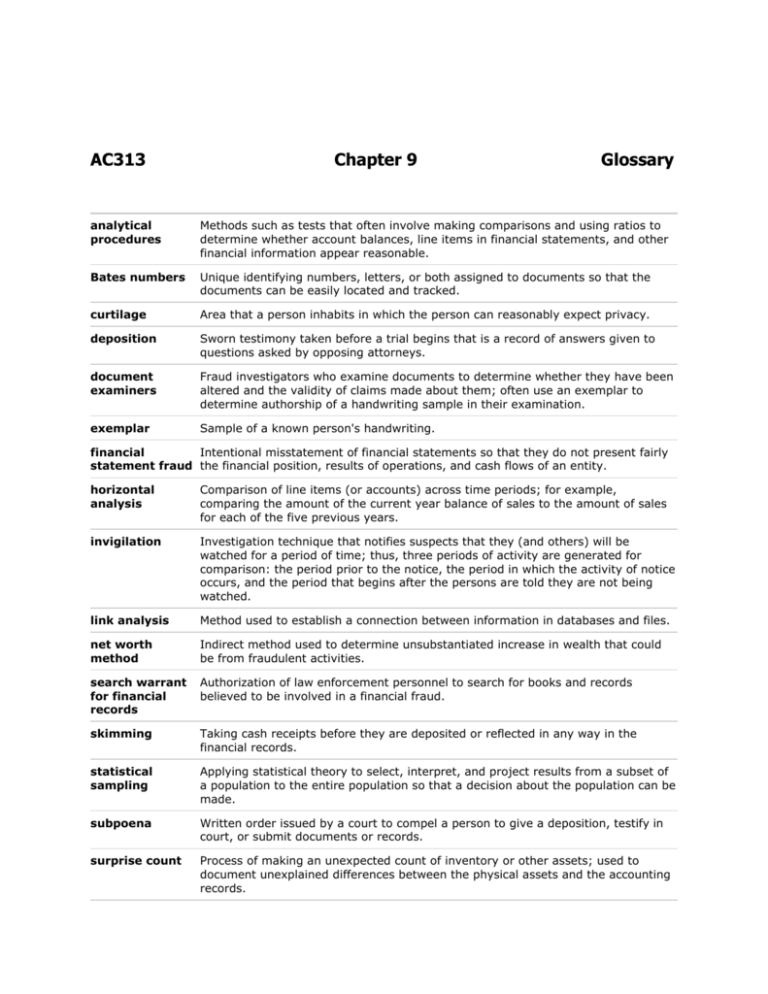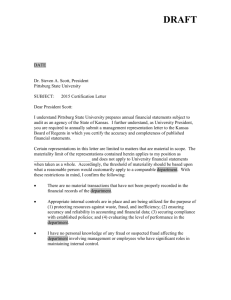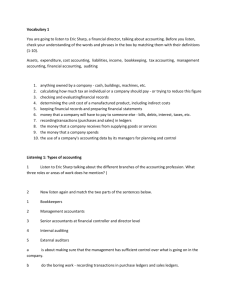AC313 Chapter 9 Glossary
advertisement

AC313 Chapter 9 Glossary analytical procedures Methods such as tests that often involve making comparisons and using ratios to determine whether account balances, line items in financial statements, and other financial information appear reasonable. Bates numbers Unique identifying numbers, letters, or both assigned to documents so that the documents can be easily located and tracked. curtilage Area that a person inhabits in which the person can reasonably expect privacy. deposition Sworn testimony taken before a trial begins that is a record of answers given to questions asked by opposing attorneys. document examiners Fraud investigators who examine documents to determine whether they have been altered and the validity of claims made about them; often use an exemplar to determine authorship of a handwriting sample in their examination. exemplar Sample of a known person's handwriting. financial Intentional misstatement of financial statements so that they do not present fairly statement fraud the financial position, results of operations, and cash flows of an entity. horizontal analysis Comparison of line items (or accounts) across time periods; for example, comparing the amount of the current year balance of sales to the amount of sales for each of the five previous years. invigilation Investigation technique that notifies suspects that they (and others) will be watched for a period of time; thus, three periods of activity are generated for comparison: the period prior to the notice, the period in which the activity of notice occurs, and the period that begins after the persons are told they are not being watched. link analysis Method used to establish a connection between information in databases and files. net worth method Indirect method used to determine unsubstantiated increase in wealth that could be from fraudulent activities. search warrant for financial records Authorization of law enforcement personnel to search for books and records believed to be involved in a financial fraud. skimming Taking cash receipts before they are deposited or reflected in any way in the financial records. statistical sampling Applying statistical theory to select, interpret, and project results from a subset of a population to the entire population so that a decision about the population can be made. subpoena Written order issued by a court to compel a person to give a deposition, testify in court, or submit documents or records. surprise count Process of making an unexpected count of inventory or other assets; used to document unexplained differences between the physical assets and the accounting records. surveillance Observation—both visual and auditory—usually done to obtain evidence for which no documentary trail is available. tracing Act of comparing information in the accounting records (e.g., ledgers and journals) to information in the financial statements or reports. Vertical analysis Comparison of accounts within a financial statement to a base account by restating each account in terms of the base account (e.g., if sales is used as the base account, it is assigned a value of 100 and all other accounts are stated relative to that account). vouching Comparing information in the financial statements or reports to information contained in the accounting records (e.g., ledgers and journals).






